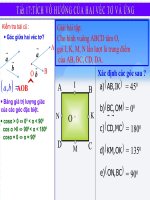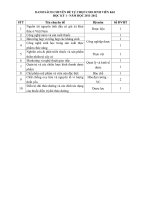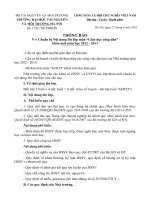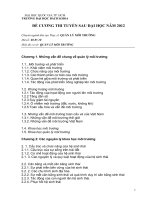2012 curves loops DRAGER
Bạn đang xem bản rút gọn của tài liệu. Xem và tải ngay bản đầy đủ của tài liệu tại đây (2.76 MB, 60 trang )
D-36-2011
Curves and Loops
in Mechanical Ventilation
Frank Rittner
Martin Döring
Curves and Loops
in Mechanical Ventilation
Frank Rittner
Martin Döring
5
Contents
Ventilation curve patterns
n
n
n
n
6
Pressure-time diagram
Flow-time diagram
Volume-time diagram
Interpretation of curve patterns
6
10
12
14
Loops – a good thing all round
21
n PV loops
n The static PV loop
n The dynamic PV loop in ventilation
n Interpretation of PV loops in ventilation
n PV loops before and after the tube
n Loops – other possibilities
n Flow-volume loop
Trends reviewed
n Documentation of a weaning process
n Lung parameters based on peak and
21
21
23
26
34
38
38
40
41
plateau pressure
43
Capnography – keeping an eye on the details
44
n The physiological capnogram
n Interpretations of capnograms
46
47
6
Ventilation curve patterns
The gradual changes
in pressure, flow and
volume depend to an
equal extent on the
properties and
settings of the
ventilator, as well as
on the respiratory
properties of the
lung.
All the ventilators of the Evita family offer graphic
representation of the gradual changes in ventilation
pressure and breathing gas flow. Evita 4,
Evita 2 dura and the PC software EvitaView
additionally show the gradual changes in the
breathing volume. Two or in some monitors three
curves can be shown on the screen at the same
time, and particularly the fact
that pressure, flow and volume can be displayed
simultaneously makes it easier to detect changes
caused by the system or the lungs. The gradual
change in pressure, flow and volume depend to an
equal extent on the properties and settings of the
ventilator, as well as on the respiratory properties of
the lung.
One respiratory cycle comprises an inspiratory
and an expiratory phase. Under normal conditions
these two periods contain a flow phase and a no
flow pause phase. No volume passes into the lung
during the no flow phase during inspiration.
Pressure-time diagram
Volume-controlled, constant flow
The pressure-time diagram shows the gradual
changes in the airway pressure. Pressure is given in
mbar (or in cmH2O,) and time in seconds.
At a preset volume (volume-controlled
ventilation) and constant flow the airway pressure
depends on the alveolar pressure and the total of all
airway resistances, and can be affected by resistance
and compliance values specific to the ventilator and
the lung. As the ventilator values are constant, the
pressure-time diagram allows conclusions to be
drawn about the status of the lung and changes to
it.
Ventilation curve patterns
Resistance = airway resistance
Compliance = compliance of the entire system
(lungs, hoses etc.)
At the beginning of inspiration the pressure between
points A and B increases dramatically on account of
the resistances in the system. The level of the pressure
at break point B is equivalent to the product of
resistance R and flow (*).
Δp = R ∗ *
This relationship, as well as the following examples, is
only valid if there is no intrinsic PEEP. The higher the
selected Flow * or overall resistance R, the greater the
pressure rise up to point B. Reduced inspiratory flow
and low resistance values lead to a low pressure at
point B.
7
Pressure-time diagram
for volume controlled
constant flow ventilation.
8
Ventilation curve patterns
The level of the
plateau pressure is
determined by the
compliance and the
tidal volume.
After point B the pressure increases in a straight
line, until the peak pressure at point C is reached.
The gradient of the pressure curve is dependent on
the inspiratory flow * and the overall compliance C.
Δp/Δt = * / C
At point C the ventilator applied the set tidal volume
and no further flow is delivered (* = 0).
As a result, pressure p quickly falls to plateau
pressure. This drop in pressure is equivalent to the
rise in pressure caused by the resistance at the
beginning of inspiration. The base line between
points A and D runs parallel to the line B - C.
Further on there may be a slight decrease in
pressure (points D to E). Lung recruitment and
leaks in the system are possible reasons for this. The
level of the plateau pressure is determined by the
compliance and the tidal volume. The difference
between plateau pressure (E) and end-expiratory
pressure F (PEEP) is obtained by dividing the
delivered volume VT (tidal volume) by compliance C.
ΔP = Pplat - PEEP
By reversing this equation the effective compliance
can easily be calculated.
C = VT /Δp
Ventilation curve patterns
9
During the plateau time no volume is supplied to the
lung, and inspiratory flow is zero. As already
mentioned, there is a displacement of volume on
account of different time constants, and this results in
pressure compensation between different
compartments of the lung.
Expiration begins at point E. Expiration is a passive
process, whereby the elastic recoil forces of the thorax
force the air against atmospheric pressure out of the
lung. The change in pressure is obtained by
multiplying exhalation resistance R of the ventilator by
expiratory flow *exp.
Δp = R ∗ *exp.
Once expiration is completely finished, pressure once
again reaches the end-expiratory level F (PEEP).
Pressure-oriented
In pressure-oriented ventilation (e.g. PCV/BIPAP) the
pressure curve is quite different.
Pressure-time
diagramm
for pressure
controlled ventilation.
10
Ventilation curve patterns
Pressure increases rapidly from the lower pressure
level (ambient pressure or PEEP) until it reaches the
upper pressure value PInsp. and then remains
constant for the inspiration time Tinsp. set on the
ventilator.
The drop in pressure during the expiratory phase
follows the same curve as in volume-oriented
ventilation, as expiration is under normal conditions
a passive process, as mentioned above. Until the
next breath pressure remains at the lower pressure
level PEEP.
As pressure is preset and regulated in the case of
pressure-oriented ventilation modes such as BIPAP,
pressure-time diagrams show either no changes, or
changes which are hard to detect, as a consequence
of changes in resistance and compliance of the
entire system.
As a general rule it can be said that the pressure
curves displayed reflect the development of pressure
measured in the ventilator. Real pressures in the
lung can only be calculated and assessed if all
influential factors are taken into account.
The course of the flow
in the expiratory
phase permits
conclusions to be
drawn as to overall
resistance and
compliance of the
lung and the system.
Flow-time diagram
The flow-time diagram shows the gradual changes
in the inspiratory and expiratory flows *insp and
*exsp respectively. Flow is given in L/min and time
in seconds. The transferred volume is calculated as
the integration of the flow * over time, and is thus
equivalent to the area underneath the flow curve.
During inspiration the course of the flow curve is
dependent on or at least strongly influenced by the
ventilation mode set on the ventilator. Only the
course of the flow in the expiratory phase permits
conclusions to be drawn as to overall resistance and
Ventilation curve patterns
11
compliance of the lung and the system.
In normal clinical practice constant flow and
decelerating flow have become established as the
standard forms for ventilator control.
To date there has been no evidence to suggest that
particular therapeutic success could be achieved using
other flow forms.
Vmax
Flow-time diagram
In the case of constant flow the volume flow rate
during inspiration remains constant throughout the
entire flow phase. When inspiration starts the flow
value very quickly rises to the value set on the
ventilator and then remains constant until the tidal
volume VT, likewise set on the ventilator, has been
delivered (this is the square area under the curve.) At
the beginning of the pause time (plateau time) the
flow rapidly returns to zero. At the end of the pause
time expiratory flow begins, the course of which
depends only on resistances in the ventilation system
and on parameters of the lung and airways. Constant
flow is a typical feature of a classic volume-oriented
mode of ventilation.
12
Ventilation curve patterns
At the end of
inspiration the
pressure in the lung
is equal to the
pressure in the
breathing system, so
there is no further
flow.
In decelerating flow the flow falls constantly after
having reached an initially high value. Under
normal conditions the flow returns to zero during
the course of inspiration. Decelerating flow is a
typical feature of a pressure-oriented ventilation
mode.
The difference in pressure between the pressure
in the lung (alveoli) and the pressure in the
breathing system, maintained by the ventilator at a
constant level, provides the driving force for the
flow.
As the filling volume in the lung increases the
pressure in the lung also rises. In other words,
the pressure difference and thus the flow drop
continuously during inspiration. At the end of
inspiration the pressure in the lung is equal to the
pressure in the breathing system, so there is no
further flow.
If at the end of inspiration and at the end of
expiration flow = 0, compliance can also be
calculated in a pressure-oriented ventilation mode
using the VT measured by the ventilator.
C = VT / ΔP
where ΔP = Pinsp. - PEEP
Volume-time diagram
The volume-time diagram shows the gradual
changes in the volume transferred during
inspiration and expiration. Volume is usually given
in ml and time in seconds.
During the inspiratory flow phase the volume
increases continuously. During the flow pause
Ventilation curve patterns
(plateau time) it remains constant as there is no
further volume entering the lung. This maximum
volume value is an index of the transferred tidal
volume and does not represent the entire volume in
the lung. The functional residual capacity (FRC) is not
taken into account. During expiration the transferred
volume decreases as a result of passive exhalation.
The relationships between pressure, flow and
volume are particularly obvious when these
parameters are all displayed at the same time.
13
Pressure, flow and
volume diagram of
volume-oriented and
pressure-oriented
ventilation
14
Ventilation curve patterns
Interpretation of curve
patterns
p
p
Changes in compliance
When compliance changes the plateau and peak
pressures change by the same amount of the
pressure difference Δp.
increasing compliance → plateau and peak
pressures fall
decreasing compliance → plateau and peak
pressures rise
Ventilation curve patterns
15
Changes in inspiratory airway resistance
When the inspiratory airway resistance changes the
peak pressure changes and the plateau pressure
remains the same.
increasing resistance → peak pressure rises
decreasing resistance → peak pressure falls
The expiratory lung resistance cannot be seen on
the pressure curve as the alveolar pressure would need
to be known. Conclusions can be drawn however from
the expiratory flow curve (see «Flow curve at
increased expiratory resistances»).
The expiratory lung
resistance cannot be
seen on the pressure
curve as the alveolar
pressure would need
to be known.
16
Ventilation curve patterns
Spontaneous breathing
During a ventilator breath the patient will try to
breathe spontaneously, and will «fight» against the
machine. Reducing the amount of time for
inspiration or, even better, changing to a mode of
ventilation where the patient is allowed to breathe
spontaneously even during a mandatory breath, is
an option worth thinking about. BIPAP or AutoFlow®
are examples of suitable modes.
Ventilation curve patterns
Adaptation of the flow curve
In volume-controlled modes of ventilation, AutoFlow®
results in automatic flow adaptation with the aim of
applying the set tidal volume at the lowest possible
airway pressure. The constant flow typical of volumeoriented ventilation modes (square) becomes at the
same time a decelerating flow form, while tidal
volume remains constant even if the compliance in
the patient’s lung changes.
Pressure limitation at a constant tidal volume can
also be achieved in Dräger ventilators by using the Pmax
setting. If the compliance of the patient changes this
set value may need to be checked and reset.
17
18
Ventilation curve patterns
The flow curve in the case of insufficient inspiration
time
If the flow does not return to zero during
inspiration this means that the inspiration time is
insufficient to apply the volume which could be
achieved for the set pressure.
Ventilation curve patterns
19
The flow curve in the case of insufficient expiration time
If the flow does not return to zero during expiration,
the expiration time is not sufficient for full expiration.
This indicates the presence of an intrinsic PEEP.
This results in an increase in lung pressure in the
case of volume-controlled ventilation.
In Evita ventilators it is possible to measure
intrinsic PEEP and trapped volume directly. An
intrinsic PEEP can have considerable effects on the
exchange of gases and pulmonary blood circulation.
In some applications, however, there may be
attempts to establish an intrinsic PEEP on purpose
(Inverse Ratio Ventilation IRV), due to the fact that this
will probably then only occur in certain desired
sections of the lung, while a PEEP set on the ventilator
will affect the entire lung.
In Evita ventilators it
is possible to
measure intrinsic
PEEP and trapped
volume directly.
20
Ventilation curve patterns
Flow curve in the case of increased expiratory
resistances
A more gentle expiratory flow curve indicates
increased expiratory resistances which may be
caused by expiratory filters which have become
damp or blocked as a result of nebulization. This
may lead to a considerable increase in expiration
time and a deviation from the set PEEP value.
21
Loops – a good thing all round
The static PV loop (classic)
PV Loops
The static PV loop (pressure-volume curve) is obtained
as a result of the «super-syringe» method, and is used
predominantly in scientific papers [1]. Most of what is
known about the PV loop is thus based on this method.
The most important feature of this PV loop is that the
individual points of measurement (pressure and
volume) are recorded when breathing gas flow = 0.
Using a super-syringe, the volume in the lung is
increased step by step. A few seconds after each
increase in volume the resulting pressure is measured
[2]. By connecting the individual points the PV loop is
created.
PV-Loop measured by
«super-syringe»
method.
22
Loops – a good thing all round
Loops – a good thing all round
The relationship of volume to pressure reflects
compliance (C = ΔV / ΔP). Thus the PV loop shows how
compliance develops as volume increases. The lower
and upper inflection points can be taken from the PV
loop. When the super-syringe method is used the
volume measured value does not return to zero during
expiration, but the reasons for this are as yet not
entirely clear. However, errors in measurement and
oxygen consumption during measurement play a
significant role [2].
In the lower section (A) the pressure per volume
increase rises particularly rapidly and only continues
in a straight line (B) once a lung-opening pressure
(lower inflection point) has been exceeded. If the lung
reaches the limits of its compliance, the rise in
pressure per volume increase becomes bigger again
(upper inflection point) (C).
It is generally accepted that ventilation should take
place as far as possible within the linear compliance
area (B), as dangerous shear forces occur as a result of
the collaborating and reopening of individual areas of
the lung. The lower inflection point can be overcome
by setting a PEEP. The ventilation volume (in
IPPV/CMV, SIMV) or inspiratory pressures (in BIPAP,
PCV) must then be selected such that the upper
inflection point will not be exceeded.
Dynamic PV loops in ventilation
PV loops which are generated during ventilation
do not fulfil the condition that at the time when
the individual measured values are recorded the
breathing gas flow should equal zero. The breathing
gas flow generates an additional pressure gradient due
to the inherent resistances like tube, airways etc. (see
also page 7).
23
PV-Loop with upper
and lower inflection
point.
24
Loops – a good thing all round
For this reason the PV loop does not give an accurate
picture of the course of compliance. The greater the
inspiratory breathing gas flow the greater the
additional pressure gradient and thus the degree of
inaccuracy.
Loops – a good thing all round
25
Since ventilators open the exhalation valve either to
ambient pressure or set PEEP at the beginning of
expiration, the pressure displayed by the PV loop also
falls almost immediately to this value.
In the static PV loop, on the other hand, the
reduction is again a gradual process.
As regards the PV loop obtained for controlled
ventilation it can generally be said that the slower the
lung is filled the better the rising branch reflects the
course of compliance.
A number of studies and publications have shown that
PV loops recorded during the course of ventilation
correlate well with loops from standard procedures, so
long as the inspiratory flow is constant [3]. The studies
are based on the assumption that the drop in pressure
resulting from inspiratory resistances will also remain
constant at constant flow, and that the steepness of
the inspiratory loop will thus reflect only the elastance
of thorax and lung. Although as a result the PV loop
recorded by the ventilator is offset (the rising branch
shifts position), it otherwise retains its original shape,
on the basis of which conclusions can be drawn about
compliance.
This also shows that in ventilation modes with
decelerating flow (BIPAP, PCV etc.) it is not possible to
draw conclusions from the PV loop concerning the
development of compliance of the lung.
In ventilation modes
with decelerating flow
(BIPAP, PCV etc.) it is
not possible to draw
conclusions from the
PV loop concerning
the development of
compliance of the
lung.









